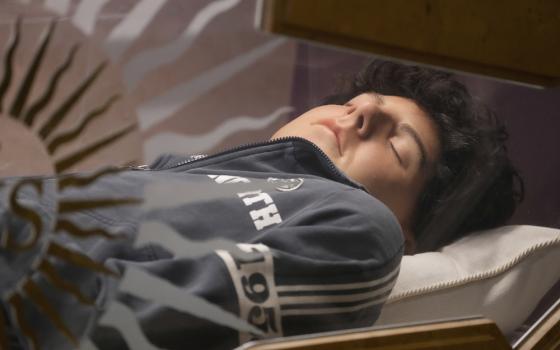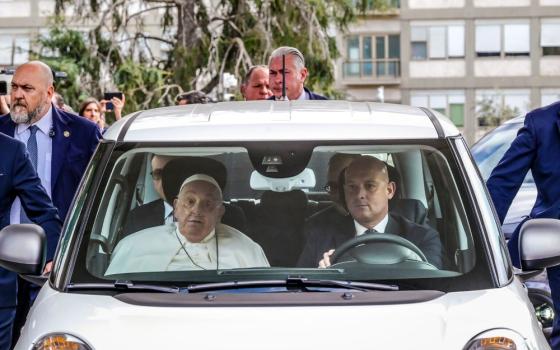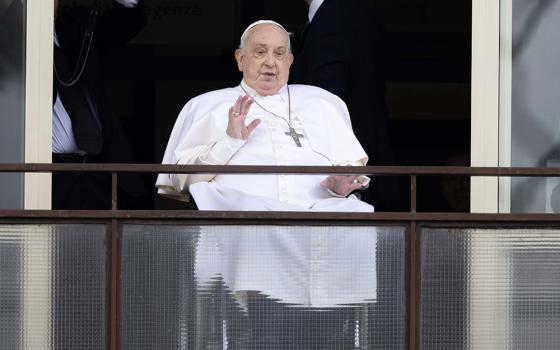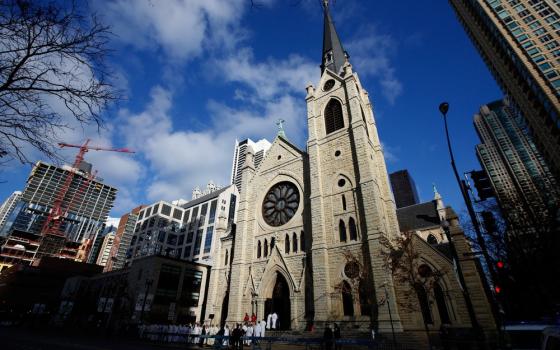Disgraced former Cardinal Theodore McCarrick, seen in this 2011 file photo, died April 3 at age 94. McCarrick was laicized in 2019 after public allegations of serial sexual misconduct. He became the highest-ranking Catholic cleric in the U.S. to face criminal charges for sexual abuse. (CNS/Reuters/Morteza Nikoubazl)
Defrocked Cardinal Theodore McCarrick, the once-powerful archbishop of Washington, D.C., who was removed from the priesthood amidst one of the worst sexual-abuse scandals in the history of the American Catholic Church, has died at the age of 94 in Missouri.
His death on April 3 was confirmed by Cardinal Robert McElroy, the recently installed archbishop of Washington. The National Catholic Reporter had reported the news earlier, attributing it to two people briefed on the matter but who asked not to be named.
Ordained in 1958, McCarrick became archbishop in Newark, New Jersey, in 1986 and then archbishop of Washington, D.C., in 2000, rising to power despite church officials’ knowledge of sexual-abuse accusations against him.
A two-year Vatican investigation into McCarrick’s tenure found credible reports of his abusive behavior dating to 1999, including an inquiry confirming that he slept with seminarians.
McCarrick was removed from the priesthood after a Vatican investigation found he had sexually molested adults and children. He became the highest-ranking Catholic cleric in the U.S. to face criminal charges for sexual abuse. In 2021, McCarrick was accused of assaulting a teenage boy at a wedding reception in Massachusetts in 1974.
“I am especially mindful of those who he harmed during the course of his priestly ministry,” McElroy said in a statement. “Through their enduring pain, may we remain steadfast in our prayers for them and for all victims of sexual abuse.”
In an explosive 2020 report that called into question the decision-making of three Catholic popes, the Vatican revealed institutional failures that led to repeated promotions for McCarrick despite rumors of his alleged sexual misconduct with young men as early as the 1990s.
Former Cardinal Theodore E. McCarrick arrives at Dedham District Court in Dedham, Mass., Sept. 3, 2021, after being charged with molesting a 16-year-old boy during a 1974 wedding reception. The charges were dismissed in 2023 due to McCarrick's cognitive decline. McCarrick, who was laicized in 2019 after public allegations of serial sexual misconduct, has died at age 94. (OSV News/Reuters/Brian Snyder)
The Vatican placed the bulk of the blame on Pope John Paul II, the now Catholic saint who appointed McCarrick as archbishop of Washington in 2000 and made him a cardinal in 2001. The report revealed that the late John Paul II, made the McCarrick appointments despite being warned in 1999 by then-New York Cardinal John O'Connor that McCarrick had been the subject of anonymous allegations and was known to invite seminarians to sleep with him in the same bed.
In 2024, a Wisconsin judge suspended charges against McCarrick ruling that he was incompetent for trial because of dementia.
In the Wisconsin criminal case, McCarrick was charged with sexually assaulting an 18-year-old man, accused of fondling him in 1977 while staying at a cabin on Geneva Lake in southeastern Wisconsin.
The alleged victim, who was not named in court records, told investigators that the former priest had repeatedly sexually assaulted him since he was 11 years old and took him to parties where other adult men abused him, according to a criminal complaint.
Pope John Paul II embraces Cardinal Theodore E. McCarrick of Washington after placing the red biretta on the new cardinal during a consistory ceremony in St. Peter's Square at the Vatican Feb. 21, 2001. McCarrick has died at age 94. (CNS/L'Osservatore Romano/Arturo Mari)
There were multiple unofficial reports to bishops and the Vatican about McCarrick's alleged misconduct between 1993 and 2016, but it was not until June 2018 that the world learned about allegations of abuse against him. That's when the Holy See removed McCarrick from public ministry, after a review board of the Archdiocese of New York determined that an allegation of sexual abuse involving a 16-year-old altar boy was "credible and substantiated."
In July 2018, The New York Times published a story exposing the pattern of sexual abuse involving adult seminarians.
The McCarrick scandal rocked the Catholic Church to the core, causing a crisis of confidence. It led many to flee the church, prompting financial troubles that still haunt dioceses across the nation and igniting worldwide outrage that ultimately forced action in the Vatican.
C. Colt Anderson, professor of Christian spirituality at Fordham University, warned against minimizing McCarrick’s significance or treating his case as an anomaly. “With Cardinal McCarrick's death, we lose one of the great villains of Roman Catholicism in the U.S.,” Anderson said.
Villanova theology professor and church observer Massimo Faggioli said the fall of McCarrick represented a turning point in the Catholic Church’s long-running sexual abuse crisis. “The McCarrick case marked the apex of the latest phase of the crisis,” he said, “because it coincided with the church’s reckoning on a truly global scale.”
Faggioli noted that the McCarrick case exploded into the public's consciousness at the same time as revelations of clergy sexual abuse in Chile, Australia and Germany. McCarrick's case stood apart because of his extensive service as a trusted Vatican emissary dispatched around the world and his reputation as one of the church's most admired cardinals.
The former prelate’s proximity to the Holy See prompted the Vatican to release the unprecedented 450-page report, an extraordinary gesture in the context of the church’s often opaque internal investigations, Faggioli said.
The 2020 report suggested that John Paul II may have been blinded by his prior friendship with McCarrick in the 1970s, and by his experience in communist Poland, where authorities would sometimes level false accusations against bishops to try and damage the church's reputation.
The scandal led Pope Francis to approve new procedures to investigate bishops accused of abuse as part of an effort to finally hold Catholic leaders accountable after decades of impunity.
The impact was felt keenly in the Archdiocese of Washington. A pastoral letter written in December to parishioners and the finance committee of a local Washington, D.C., parish reported that the archdiocese has run an annual deficit of $10 million since McCarrick's crimes came to light in 2018.
The letter, reviewed by NCR and later removed from a church bulletin board, said Cardinal Wilton Gregory took steps to close the McCarrick-linked deficit by implementing budget cuts in the archdiocese, installing a new assessment system of local parishes, and jump-starting the archdiocesan annual appeal "on better footing."
The ramifications continue to this day. Incoming McElroy, installed in March as the archbishop of Washington, has been criticized by mostly conservative detractors for allegedly not responding to a whistleblower letter regarding McCarrick when McElroy was bishop of San Diego. An NCR review of the facts and documents available regarding the episode show that McElroy appears to have taken every reasonable step to pursue the unsubstantiated allegations.
In February, Cardinal Joseph Tobin of Newark, New Jersey launched an investigation into whether the president of Seton Hall University, Msgr. Joseph Reilly, failed in his responsibilities regarding McCarrick.
Reilly, named president of Seton Hall a year ago, allegedly knew of sexual abuse allegations that he did not report, Politico reported last year. The Politico report prompted Tobin to hire an outside law firm to investigate whether Reilly “acted inappropriately.”
Comparing today’s Catholic landscape with the world McCarrick once navigated, Villanova’s Faggioli sees clear progress in addressing abuse.
“In terms of practice, training and institutional safeguards, many steps forward have been taken,” he said.
McCarrick himself played a role in shaping these reforms — serving at the heart of the U.S. bishops' conference during the early 2000s as it began to act more decisively on abuse. And yet, the damage done to the church’s unity has been lasting.
While the church has implemented stronger safeguards, Faggioli warned against a false sense of security in the church.
“The American Catholic Church is now entangled in broader national, political, and cultural crises,” he said. “That struggle, especially to preserve its charitable missions, risks drawing focus away from key priorities like abuse prevention.”
In recent years, McCarrick had been in the care of Vianney Renewal Center, a facility outside St. Louis, Missouri, operated by a Roman Catholic order called the Servants of the Paraclete, who care for religious men who are ill. Shortly before McCarrick died, he was moved to a nursing facility, also in Missouri, where he died, according to two people briefed on the matter.
Then-Archbishop Theodore McCarrick blesses bishops, priests and guests after being installed as Washington's archbishop at St. Matthew's Cathedral in Washington in this Jan. 3, 2001, file photo. (CNS/Nancy Wiechec)
Theodore Edgar McCarrick was born in New York City in 1930.
The only child of Theodore Egan McCarrick, a ship's captain, and Margaret McLaughlin, a factory worker, McCarrick was raised in the Washington Heights neighborhood of Manhattan, according to his archived biography.
His upbringing during the Great Depression was hardscrabble. His father died of tuberculosis when he was just 3 years old, and his mother supported the family by working in a Bronx auto parts factory. As a boy, he served as an altar boy at his local parish and developed a strong interest in the priesthood.
McCarrick attended Fordham Preparatory School and studied languages in Switzerland before returning to New York to enroll at Fordham University. He went on to St. Joseph's Seminary in Yonkers, earning a bachelor's degree in philosophy in 1954 and a master’s in history in 1958. He was ordained a priest by New York's Cardinal Francis Spellman in 1958.
McCarrick earned a master's in social science in 1960 and a doctorate in sociology in 1963 from the Catholic University of America in Washington, D.C. From 1965 to 1969, he served as president of the Pontifical Catholic University of Puerto Rico, significantly developing the institution. He later returned home to New York to become a close aide to Cardinal Terence Cooke.
Named auxiliary bishop of New York in 1977, McCarrick went on to lead dioceses in Metuchen and Newark before being appointed archbishop of Washington in 2001 and elevated to cardinal weeks later by Pope John Paul II.
Advertisement
Before his fall from grace, McCarrick was one of the most visible and active figures in the American Catholic Church. A polyglot fluent in four languages and well-versed in global affairs, McCarrick spent decades crisscrossing continents on behalf of the Vatican and Catholic Relief Services, as well as the U.S. government.
McCarrick's travels took him to the rubble of natural disasters and to the halls of power, meeting world leaders like Fidel Castro and lobbying U.S. presidents on immigration and aid. In public, he presented as a charismatic centrist — firm on Catholic doctrine yet committed to progressive social advocacy.
Though McCarrick was nearing the standard retirement age, John Paul II in 2000 appointed him to be archbishop of Washington, where his diplomatic finesse and political connections made him a natural fit for the capital's ecclesiastical helm. He quickly became a high-profile leader among the more than half a million Catholics in the archdiocese, which included large Spanish-speaking and African American communities.
McCarrick's reputation as a public churchman grew during the early 2000s. He appeared regularly in the media, raised hundreds of millions for Catholic causes, opened a seminary, and ordained scores of new priests even amid declining vocations.
Seen as a bridge-builder, both politically and within the Church, McCarrick often positioned himself in the ideological center of an increasingly divided Catholic hierarchy. "If you stand in the middle, you can meet both sides," McCarrick once said, invoking the Latin phrase in medio stat virtus — virtue stands in the middle.
Ironically, he also played a central role in the church's response to the 2002 sexual abuse crisis. After consulting with the Vatican, McCarrick announced a "one strike and you're out" policy for new abuse cases — a message that helped shape the U.S. bishops' eventual zero-tolerance stance. At the time, McCarrick was seen as a trusted voice of reform.
Before his disgrace, McCarrick had become a roving elder statesman under Pope Francis, who brought him back into informal diplomatic roles after the more reserved pontificate of Benedict XVI.
Into his 80s, McCarrick remained remarkably active. He jetted to Sri Lanka after the 2004 tsunami, flew to New Orleans in 2005 after Hurricane Katrina, and made sensitive forays into China, Iran and the Central African Republic. He worked behind the scenes to promote interfaith dialogue and religious freedom in conflict zones.
In interviews, McCarrick downplayed his intellect and positioned himself as a man of action. He saw himself as someone who could connect people across ideological and religious divides, often at the personal request of Pope Francis. For many, McCarrick's energy and idealism made his eventual downfall all the more painful. He embodied the contradiction of a man revered for his public service, while privately violating the very values he espoused.
In 2000, McCarrick was asked about an inquiry initiated by John Paul that confirmed he slept with seminarians. John Paul believed McCarrick's handwritten denial that said, "I have made mistakes and may have sometimes lacked in prudence, but in the seventy years of my life I have never had sexual relations with any person, male or female, young or old, cleric or lay."
In 2004, McCarrick, a frequent guest on NBC's public affairs show "Meet the Press,:" was asked about a report on the causes of the sexual-abuse scandal. Then-host Tim Russert read to McCarrick from the report: "The inaction of those bishops who failed to protect their people from predators was also grievously sinful. Somehow, the 'smoke of Satan' was allowed to enter the Church, and as a result, the Church itself has been deeply wounded."
Russert asked, "Do you disagree with any of that?"
McCarrick replied: "I think basically it is a good summary of what happened in the past. Basically, it demonstrates that the church is made of saints and sinners and sometimes the sinners find their way into the clergy. And, well, since we're all sinners, we can see how that can happen."








